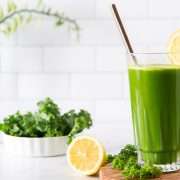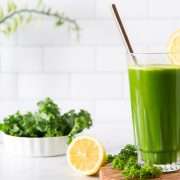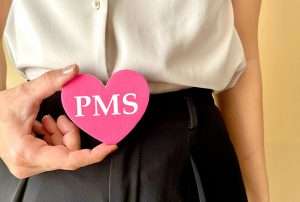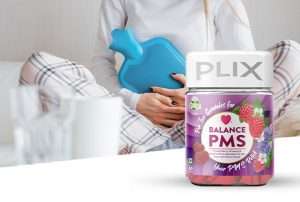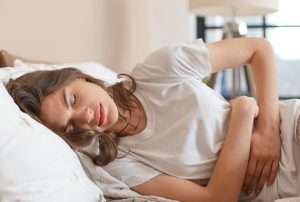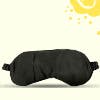6 Signs of PMS & Treatment

Premenstrual syndrome (PMS) affects nearly 90% of women before their period. PMS are period symptoms that usually appear one to two weeks before the first day of menstruation, with some women suffering from severe symptoms and others suffering from mild symptoms. Whether you’re just starting your period or want to learn more about how your body works, you should educate yourself on signs of PMS so you know how to treat them, from investing in a heating pad to help with cramps to purchasing PMS vitamins to reduce the severity of your symptoms.
Why Does PMS Happen?
Although the exact cause of PMS is unknown, most experts believe that it is caused by a hormonal imbalance. Most women ovulate and experience hormonal fluctuations as signs of PMS during the time before their period. These bodily changes appear to affect each menstruating person differently, resulting in a wide range of severity of symptoms between individuals.
Signs and Symptoms of PMS (Symptoms of period)
1. Breast pain
Breast pain is one of the most common PMS symptoms. You will most likely experience swelling and tenderness, which can range from mild to severe and can worsen right before your period. Women of childbearing age are more likely to experience worse symptoms. Fullness in the breast tissue is likely, accompanied by a heavy and dull pain.
2. Mood swings
Almost all women experience mood swings when they are PMSing. You might be happy one moment and start crying the next. PMS moodiness is characterised by anxiety and crying spells.
3. Fatigue
When you have PMS, you are more likely to experience physical exhaustion, tiredness, fatigue, and sleeping difficulties. You can correct this by doing some exercises. It will alleviate your symptoms. Take no medication during this time.
4. Cravings
When that time of the month arrives, your eating habits are likely to change. PMS symptoms can cause you to crave sweet and salty foods. You might want to stock up on sweets, chocolates, cakes, ice cream, and salty snacks. You may even experience a loss of appetite as a result of abdominal discomfort.
5. Cramping
Cramping occurs during menstruation as well as prior to it. You are more likely to have dysmenorrhea if you have PMS. Cramping may occur two days before your period and may subside during your period as blood flow decreases.
6. Bloating
If you have PMS, you will most likely feel bloated for the first few days. This can temporarily suppress your appetite. When your period ends, the bloating may return to normal.
7. Nausea
Nausea is a less common symptom. Even if your period is a few days late, you should not expect digestive distress. However, you may experience nausea in addition to other PMS symptoms in some cases.
8. Stress and PMS
Research continues to show a strong link between stress and menstruation. It can also have an effect on the hypothalamus. Here’s how stress affects your menstrual cycle: Hormones are released by the hypothalamus and pituitary gland, causing the ovaries to respond. The delicate balance of your released hormones (oestrogen and progesterone) can ultimately determine the flow of your menstrual cycle. These hormone patterns can be significantly influenced by stress. Excessive stress can cause your periods to stop completely by throwing your ovulation cycle out of whack. Estrogen is responsible for the formation of the uterine lining, which prepares the body for pregnancy. Missed or irregular periods could be a side effect of stress affecting the ovaries. To summarise, yes, stress can disrupt the balance of your hormones, but it is possible to reduce stress and find simple coping mechanisms!
How to Relieve Symptoms of PMS (before period symptoms)
Unfortunately, there is nothing that can prevent PMS symptoms from occurring, but there are numerous ways to alleviate PMS symptoms. Each person has a unique experience with PMS symptoms. Some people’s PMS symptoms are so severe that they are unable to function normally because they are in so much pain and suffering. Others experience milder symptoms that can still interfere with their daily lives. Pain relievers and heating pads are two popular methods for relieving physical symptoms of PMS. These techniques can help with symptoms like headaches, cramps, and muscle pain. Following a healthy lifestyle can help treat all three types of PMS symptoms. Physical activity on a regular basis can help with anxiety, mental focus, and fatigue.
Getting enough sleep each night, at least 8 hours, can help you feel less irritable and anxious. In the weeks preceding menstruation, eating healthier foods low in caffeine, salt, and sugar can help reduce symptoms. Certain lifestyle practises frequently aggravate PMS symptoms. While these practises do not cause PMS, they do worsen the symptoms. Depression, lack of exercise, lack of sleep, smoking, and stress are examples of unhealthy lifestyle choices.
Vitamins for PMS can be an excellent way to alleviate symptoms without making too many changes to your daily routine. To reap the full benefits of vitamins for PMS, take it on a daily basis, just like any other vitamin. It’s not just for when you expect your symptoms to appear. This gives you a head start in preparing your body to fight PMS symptoms. There are several PMS vitamins on the market, such as FLO, so try to find one that works best for you and use it for at least two menstrual cycles to reap the benefits. If you’re having trouble managing period symptoms, such as extreme pain or an increase in unhealthy thoughts, it’s a good idea to see your doctor. There is no way to completely eliminate PMS symptoms, but there are ways to alleviate the discomfort. Here are some suggestions for treating PMS.
1. Cuddle up
PMS cramps are caused by uterine contractions. Relaxing your muscles is essential for reducing muscle contractions. Your body can relax by cuddling up in the foetal position. A hot water bottle pressed against your lower abdomen will also help relax your muscles if you have severe cramps.
2. Indulge in a warm bath
A warm bath is an excellent PMS treatment because it relaxes your muscles. That little peaceful time will also help to calm your mind and lift your spirits.
3. Track your symptoms
Not everyone would do this, but it is beneficial to keep track of your menstrual cycle and the emotions you experience at each stage. This will eventually help you realise that your mood swings are caused by your periods. And once you understand what caused that sudden outburst, you will be able to feel better and keep things under control.
4. Dietary measures
Increase your intake of calcium-rich foods such as milk, cheese, curds, and green leafy vegetables, as well as vitamin B-6, which you can get from fish, chicken, fruits, and cereal.
5. Indulge in healthy cravings
Your body has its own way of dealing with PMS. Food cravings do not always occur at random during your period. Have a sweet tooth? There is a reason for this! Chocolate contains chemicals that are known to improve your mood. As a result, you will feel a little better.
6. Drink fluids
Bloating is one of the common periods symptoms caused by your body’s ability to retain water during your period, making you feel bloated. Drinking plenty of water, ironically, will help combat water retention by flushing out excess water from the body. So, to avoid bloating, drink plenty of water during your period.
7. Reduce stress
The combination of stress and the menstrual cycle is extremely dangerous. Stress has been shown to aggravate PMS symptoms. A few breathing exercises will help you cope better with this.
8. Workout
Make certain that your body receives adequate exercise. Endorphins are chemicals in your brain that boost your mood and change the way you perceive pain. They will relax your muscles and make you feel better. However, don’t overdo it. After all, the goal is to find treatments for premenstrual symptoms, not to exacerbate them.
We would like you to check out Plix’s PMS Balance Gummies That can help relieve the above-mentioned symptoms of PMS. These are completely plant-based and provide stress relief, stabilize mood and reduce PMS cramps and irritability.
FAQs.
1. What are the symptoms of PMS?
Breast pain, mood swings, fatigue, cravings, cramping, bloating and nausea are some of the symptoms of PMS.
2. What are the natural ways of relieving PMS symptoms?
Warm water bath, calcium-rich diet, Yoga & exercise, and plant-based natural supplementation can help relieve PMS symptoms.
3. Do Plix’s PMS Supplements help with menopause?
Yes, PMS supplements help to balance hormones and boost our nervous system, keeping mood swings, irritability, and acne at bay during menopause.
4. How Long Can You Take a PMS Supplement?
We recommend consuming it on a daily basis and incorporating it into your diet to prevent PMS and improve your overall health.
5. Are There Any Negative Side Effects?
We only use natural ingredients in our gummies, such as chaste berry, ginseng, vitamin B6, and magnesium, which have been shown to have significant effects in preventing PMS. However, if you have an allergy or a health problem, you should consult a doctor before consuming.

